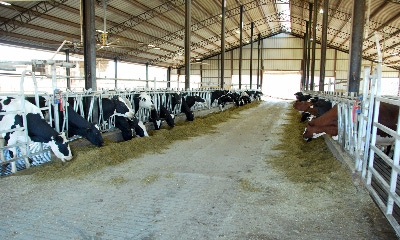June 7, 2016

Nelson Hostetler brought his cows off pasture and erected a new confined dairy shed. He found the news system added roughly 2,000 more pounds of milk per day to the operation. And while the new system increased production, it protects the environment.
The dairy farmer from southwest Missouri renovated his operation to include a structure to house cows along with a new animal waste system.

PROTECTED: Bringing cattle under roof allows them to be protected from the weather elements. However, it also allows dairy farmer Nelson Hostetler to manage his waste. Manure is spread on nearby fields and the sand bedding is recycled and reused in the barn.
Inside the dairy barn, the alleys are part of a flush system in which water is released from large, gravity-driven flush tanks. The water washes the animals' waste and the sand that is kicked out of the stalls to an outside area. There the sand settles out and the water and waste enter a gravity solid separator. The solid waste remains in the separator and the liquid travels through a pipe to a lagoon. The liquid is then pumped from the lagoon back into the tanks for re-use.
Then he recycles the sand bedding. The sand is pushed into piles where it dries in the sun, and is put back into the stalls. The solid waste is eventually removed from the separator and spread onto Hostetler's crop fields.
The environment
The system protects the environment by keeping animal waste on-farm, where it is re-used as nutrients instead of washing into streams.
"NRCS' interest is in protecting the quality and healthfulness of the natural resources that everyone needs," says State Conservationist J.R. Flores. "Situations like Mr. Hostetler's in which actions taken to protect the environment also improve his operation are great, because everyone benefits."

REALIZING BENEFITS: Nelson Hostetler (right) and NRCS engineer Michael Malone discuss the effectiveness of the new waste system outside of the new dairy shed in Polk County.
NRCS engineers worked with Hostetler to design a system to meet his wishes, while also addressing the resource concerns. Michael Malone, NRCS civil engineer, says he, Hostetler, and NRCS Area Engineer John Feistner visited a number of other dairy farms to get ideas about what would work best at Hostetler's farm near Louisburg.
The assistance
"We went through multiple design revisions until we finally found one that fit him," Malone says.
"What I have is kind of what I always dreamed about," Hostetler says. "Without (NRCS') help, we would not have been able to do this. We would have had to do it in small stages."
Hostetler says he originally sought NRCS assistance just to install a lagoon. That changed when Malone and Feistner described other options.
The system he ended up with is tons better.
Through its Environmental Quality Incentives Program or EQIP, NRCS paid part of the costs of the concrete alleys, flush system, solid waste separator, lagoon and the section of the roof over the alleys. Hostetler says that NRCS financial assistance covered about half of the cost of his new system.
Flores says that 60% of Missouri's general EQIP funding goes to livestock operations. In Fiscal Year 2015, NRCS obligated $14.4 million on 500 livestock farms, including beef, dairy, hog and poultry operations.
Rahm is a public affairs officer for USDA NRCS in Columbia.
You May Also Like




